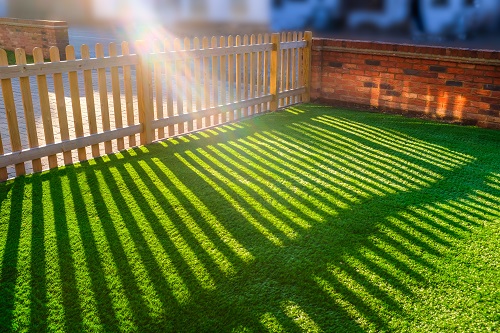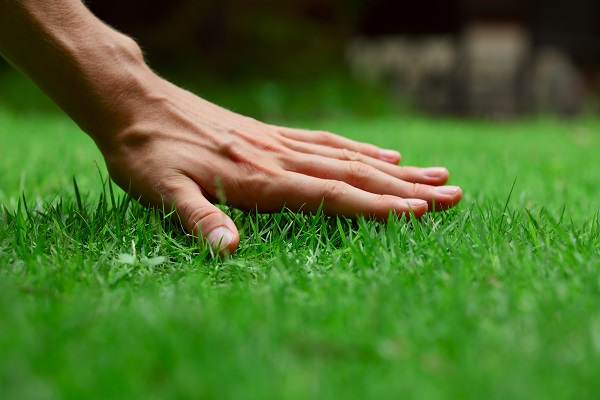If you are a homeowner about to install new sod, there are several things that you should know that many homeowners wished they knew when they started. These tips will help you save a lot of time and money and at the same time keep your sod looking amazing just like those maintained by professionals. Keeping sod does not need to be difficult or expensive as long as you follow these simple and easy-to-do tips.
How much should I water new sod?
The riskiest time for sod is when it is just newly installed. This is particularly true in times and places where high temperatures are common such as those we experience here in Arizona. Summer days are among the most dangerous as they could lead to several patches of sod drying out and destroying the overall beauty of your sod.
The best time to water established lawns is either in the morning or the evening. This is because if you water your lawn in the middle of the day when it’s very warm, the water will evaporate quickly.
For new sod that has been recently installed, we recommend watering 4-8 times a day for about 5-10 minutes each. You just need to do this for the first two weeks following installation and then you can cut down to watering once a day for about 15-45 minutes each. When the sod is properly established you can water your lawn 2-3 times a week for 10-25 minutes each time.
Related: Lawn Care – Sod Irrigation
This schedule changes during colder times such as winter (for overseeded sod) where you should water twice a day for 10-15 minutes for the first two weeks after installation and only once a day after that for 15-20 minutes each. For well-established lawns during the colder times, you should keep an eye on the weather since it will dictate the amount and frequency of watering.
The general rule of thumb here is that when you are experiencing hotter weather, you should water more frequently but when you are experiencing colder weather, you can water your sod less frequently.
You can make this easier for you by hiring professionals to take care of all the needs of your sod. You might have to dole out some cash but this way you will ensure that you remove the guesswork of taking care of your lawn and the risk of having patches of your lawn die or dry out.
When Should I Fertilize?
To get the best results for a healthy lawn, fertilizing should be done every 30 days. Just like humans, lawns need good nutrition to keep them free from weeds and disease. This will help them to thrive and look healthy. The best Nitrogen-Phosphate-Potassium (N-P-K) ratio of fertilizer we recommend is a 21-7-14 or 16-8-4.
Keeping a good fertilizing schedule is important because fertilizers nourish your lawn. Look at fertilizers as food for plants and when you give them an adequate amount of food, they will grow and take root properly, which will protect your lawn from extreme weather or temperatures as well as other stressors that the lawn might encounter. However, you should keep in mind that you might have to reassess your fertilizing schedule depending on the type of sod you are using since different varieties of sod have different needs. You should also consider the weather and season when planning your fertilizing schedule.
During springtime, you should consider having a fertilizing schedule for early spring and late spring. During early spring, plants are generally waking up from their hibernation during the winter. This means that they have expended much of their stored nutrients during this time and require more care. On the other hand, during late spring, your lawn needs all the help it can get to prepare for the coming stresses of summer and fall.
During the summer, in hotter areas like Arizona, your lawn is experiencing heavier stress because of the heat and bugs. Fertilizing during this time will help make sure that your lawn keeps healthy going into the fall.
Related: Lawn Care – Sod Nutrition
When fall comes, so will the opportunity to entertain guests and other outdoor entertainment. This is also the season when your lawn begins to prepare for another growth period. This means that your sod needs more nutrients to help keep it healthy and strong. However, this is also the best time for your sod to thrive since nature is giving you a hand. You will be experiencing more rainfall and cooler times during this time which will make taking care of your lawn easier.
If you want more information about when to fertilize your lawn, you can go to Evergreenturf.com and get expert advice on the best fertilizing schedule for your lawn.
How Long Does It Take New Sod to Root?
This is a difficult question to answer simply. Sod taking root generally has two stages: Formation of shallow roots and formation of deep roots. To get the best results, you should give sod the right care during these periods to ensure that your lawn thrives in the long term. Strong roots mean that sod becomes more resilient against any stressors that it might encounter.
Forming shallow roots can begin as early as two weeks. To help this process along, you should water your new lawn right after the sod is installed. After the first week of laying the sod, it is recommended that you water your sod daily to make the process quicker. You need to take particular care during this stage since this process is among the most sensitive times for the sod. Avoiding adding stress to your lawn during this time will help it grow and thrive in the future. You should minimize stepping on it or adding any kind of weight to allow it time to grow the roots it needs for the future.
Related: How Long Does it Take for Sod to Root
On the other hand, deep roots require that you water your sod less. This will encourage your lawn to develop deep roots. If done right, your sod will be able to develop deep roots in about 30-45 days. When this happens, it is a sign that your lawn is ready to face added pressure such as mowing and foot traffic.
Be sure to wait to mow your lawn for the first time after 48 hours or two days after watering to prevent damage to the grass blades. Also, set your mower to 3 inches. This is the optimum height for your lawn to keep healthy during this sensitive time.
To further encourage faster rooting, you can use a lawn roller right after the sod is installed. Rolling the sod carefully will allow the new sod and the topsoil to adhere faster and will also remove air pockets that will slow the growth rate of roots. You can also start fertilizing your lawn after six weeks of installation.
To help this process along, you should also prepare the soil where the sod will be placed. Most grass species thrive on acidic, well-drained soil. You can add Sulfur, Compost, and Lime to your soil before the installation of sod to prepare it. This will increase the chances of a fully healthy and great-looking lawn that will begin taking root in about two weeks.
If you need more information about preparing your soil, you can go to Evergreenturf.com and receive advice from experts in this industry. If you want to remove the guesswork when installing the best high-quality sod, we also offer installation for a reasonable price!
Mistakes to Avoid
Don’t Overwater before Installing New Sod
We know that getting new sod can be an exciting prospect and you want to do everything you can to make sure that the installation goes smoothly. You might be tempted to overwater your lawn thinking that it will help make the installation and growth go faster but this is more dangerous and might negatively affect a successful installation. Muddy grounds make working on it more difficult and can lead to poor sod growth. What you want here is to keep the lawn just moist but not soaked. Please see above for watering schedules that provide the moisture your sod needs and help you avoid overwatering.
Don’t Mow Too Soon
Mowing can cause severe damage to a newly installed sod. Do not mow your new sod lawn until about two weeks after installation. However, keep in mind that you must remove only 1/3 of the leaf blade to prevent scalping or damaging the new lawn. This means that you might have to mow your lawn more frequently or about every 3 days to reach the growing height that you want but we promise you it will be worth it.
Mowing a lawn depends on how quickly your sod is growing. There are some varieties and conditions that grow faster like Tiffgreen sod lawn where you might have to mow every 2-3 days as compared to midiron hybrid Bermuda sol lawn which needs to be mowed once every 7-19 days. This might require you to mow more often but as long as you remember the general rule “never remove more than 1/3 of the leaf” then you should be fine.
Related: Lawn Care – Mowing Sod
If you plan on mowing less often, you should also remember that you should keep your mowing height up and the fertility of your land down. Keeping your fertility low will slow the growth of your grass and the higher mowing height allows for more leeway for the grass to grow without it becoming cumbersome and remain looking crisp even with less frequent maintenance mowing. However, the best-looking lawns are those that follow these three things mow lower, fertilize frequently, and mow frequently. If you need more information about mowing, follow this link and read more https://www.evergreenturf.com/lawn-care/mowing.php
Another thing to keep in mind is when dealing with new sod, your first mowing should start when your sod has been established for one week. You will also have to cut back on watering the sod to keep the ground firm enough and not leave any marks when you mow. Follow the general rule that you should not remove more than 1/3 of the leaf and the mower blade must be sharp when mowing for the first time on newly installed sod. Keeping your lawnmower’s blade sharp will prevent pulling and leaving yellow scalped areas on the new lawn.
You should also start thinking of the lawnmowing equipment you plan to use on your lawn as early as you can. There are generally two types of mowing equipment, and both have their pros and cons. The first type of mowing equipment is the electric or gas reel mowers. These machines have typically 7 or 10 blades and are used to mow grass up to ¾ of an inch. They tend to cost more and require more maintenance, but they give a higher quality cut as compared to the rotary push mowers and can mow as low as 1/3 of an inch. They are recommended for any type of grass
On the other hand, rotary push mowers, or more commonly, push mowers, can be used to mow lawns between 3/4 to 3 inches. They are cheaper, hardier, and require less maintenance as compared to electric or gas reel mowers but they don’t produce as good as cut. They also can’t cut below ¾ of an inch which makes for a less crisp look to your lawn. However, they are ideal for Midiron, Paspalum, St. Augustine, and Celebration Bermudagrass variants.
Be Careful with Weed Control
Herbicides are substances that kill or prevent the growth of plants in an area. You can use them to keep your lawn safe from unwanted plants and weeds and keep your lawn looking amazing. There are several kinds of herbicides you can use and one of them is called post-emergent herbicides. These substances affect weeds after they have sprouted and established themselves on your lawn. On the other hand, there are herbicides called pre-emergent herbicides that are used before you can observe any signs of weeds.
Post-emergence herbicides can control existing weed growth and help prevent future ones but can be dangerous for certain kinds of plants and sod varieties so you must use the right kind of herbicides for your use. There is also a particular way you should be using them to work properly to keep the plants you want unaffected. Be sure to look into how they are used properly.
There are different kinds of post-emergent weed killers. They generally fall under systemic and contact herbicides. Systemics are the most effective when used on perennial or long-time weeds since it goes directly into the plant for the best results. On the other hand, contact herbicides only kill the exposed portions of the plant and are effective on annuals or smaller weeds since killing the exposed parts would likely lead to the whole plant dying.
Knowing the right kind of herbicide to use can determine whether or not your efforts kill only the weeds and not affect the plants you want to be unaffected. This requires an understanding of the substance and its careful application.
Pre-emergent herbicides are generally more effective to control weeds before they have grown, while post-emergent herbicides can be used any time after the weeds have grown. Be careful though, as a lot of post-emergent herbicides could damage the lawn if used too much or applied at the wrong time. Always read the instructions on using herbicides before applying any kind of chemical to your sod grass lawns. You can learn more here https://www.gardeningknowhow.com/plant-problems/weeds/post-emergent-herbicides.htm.
Conclusion
Taking care of new sod can be easy as long as you know the basics of sod care. Many people don’t take the time and effort to learn this and as a result, they find a less than ideal looking patch of land. This costs them time, money, and effort when they simply could have done a little bit of research. These simple tips and tricks to take care of your newly installed lawn will be helpful to you as you begin your taking proper and active care of your lawn.
If you would rather remove the guesswork on your lawn care and choose to ask professionals for help, contact Evergreen Turf today. We have been in the industry since 1999, and we pride ourselves in being a locally owned and operated Arizona sod farm.



